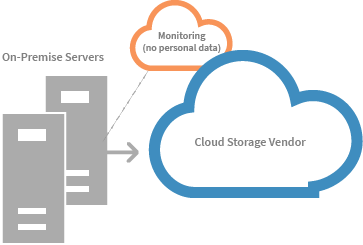With the popularity of cheap and convenient online migration tools, it’s hard to imagine why there would still be a need for typically outdated and expensive on-premise migration software. But with concerns over cloud security and reliability, is there a better way?
When Amazon Web Services went down on the 28th of February 2017, it brought concerns about cloud reliability bubbling to the surface. As the largest cloud hosting provider, many companies were affected. I use several cloud-based tools, and I watched in horror as everything ground to a halt.
Similarly, cloud security became an even hotter topic with the Cloudflare breach earlier this year. The breach was caused by a major security flaw in the Cloudflare software that exposed user login details, private messages and other sensitive information from popular apps like Uber, Fitbit and OKCupid over a period of months.
These two examples are the products of internal errors, not of nefarious designs. But it does pose the question: if these sorts of mistakes can happen without the assistance of a hacker, how safe is your data if someone really wants access to it?
Public clouds are hugely attractive targets to hackers because of the sheer quantity of sensitive data contained within them. Additionally, the rate of technological development is outstripping the pace of regulatory authorities. Therefore it may be some time before the cloud is truly a safe and reliable place to store data. The GDPR in Europe is the first major step to regulate the industry, with offenders potentially being fined up to 5% of their worldwide turnover.
But here’s the rub: the cloud is such a convenient, cost effective and easy place to store data that we all want to use it. In fact, I would hazard a guess that everyone reading this article has at least some data stored in the cloud.
Storing data is one thing. Assuming you do due diligence ,you can mitigate many privacy and security risks associated with cloud storage.
But what if you’re migrating your data to the cloud? For something you hope to only do once, is it necessary to go through all the same steps to ensure your data is secure?
If you’re using a cloud migration provider, the answer is yes.
It is imperative you perform the same due diligence to ensure your data is safe when moving from an on-premise server, to one in the cloud.
Your other option is an on-premise migration tool. These tools can move your data from your company sever to the cloud, without having to go through any middle-men servers on the way.

Pros
Cons

Pros
Cons
Neither solution is perfect, and it can be difficult to choose between options that both suffer from significant drawbacks.
Because of this, what is really needed is a hybrid model. An on-premise solution that offers similar features and licensing models to cloud solutions, while continuing to offer the increased security, speed and reliability of an on-premise tool.
While there haven’t been many companies to adopt this approach yet, with our latest release of Aid4Mail, this is what we have tried to achieve.

Pros
Cons
More on-premise migration vendors need to adopt a hybrid approach that allows their customers to benefit from the security of an on-premise tool, with the convenience of a cloud solution. Until the industry has matured we will continue to see data breaches and outages. Because of this, unnecessary risks and costs should be avoided wherever possible with a one-time migration. Even when the industry matures and data breaches and outages become less common, some highly regulated industries (like finance, healthcare and aviation) will be required to take extra precautions when migrating their data.
For the foreseeable future, there is still a place for on-premise migration tools. But this doesn’t mean they need to be inconvenient, costly and slow to improve. On-premise vendors can’t allow themselves to stagnate, and should start taking steps to move their offerings into the 21st century.
 By Katie Cullen Montgomerie
By Katie Cullen Montgomerie
Katie is the marketing and communications manager for Fookes Software, the developers of email migration software Aid4Mail. A new version of Aid4Mail Migrator has recently been released that takes the hybrid approach to on-premise email migrations.





